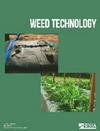评估行宽和喷头选择对水稻喷洒覆盖率和除草效果的影响
IF 1.3
3区 农林科学
Q3 AGRONOMY
引用次数: 0
摘要
稗草和其他令人头疼的杂草已成为水稻淹没系统中生产者面临的主要问题。文化控制方案和更有效的除草剂施用已成为提高效率和控制水稻杂草的优先事项。本研究旨在确定行宽和喷嘴选择对水稻系统喷洒覆盖率和杂草控制的影响。在 7 个地点-年(2021 年和 2022 年,美国阿肯色州隆诺克市;2021 年和 2022 年,美国阿肯色州松树市;2022 年,美国阿肯色州罗沃市;2021 年和 2022 年,密歇根州斯通维尔市)进行了田间试验,试验采用随机完全区组分割小区设计。施用除草剂时使用了五种喷嘴(XR、AIXR、TTI、TTI60 和 AITTJ60)(子小区因子),地块以四种行宽(整小区因子)(13、19、25 和 38 厘米)进行钻播。进行了液滴大小实验,以评估田间试验中使用的每种喷嘴的液滴大小和速度。总体而言,随着行宽的增加,稗草密度也随之增加。种植宽度较宽的水稻需要更长的时间来形成冠层闭合,从而使作物中的杂草逃逸。例如,与淹水前的 38 厘米行宽相比,13 厘米行宽的冠层覆盖率增加了 12 个百分点,导致每平方米减少了 6 株稗草。在整个研究过程中,液滴尺寸最小的喷嘴(XR)的除草效果更好,但更容易发生漂移。双风扇喷嘴(AITTJ60 和 TTI60)对杂草控制的影响各不相同,很难预测何时会出现这种情况;不过,与单风扇喷嘴(AIXR 和 TTI)相比,它们确实增加了对水敏感的卡片上的沉积物。总之,较窄的行宽(例如 19 厘米或更小)和较小液滴尺寸的喷嘴(XR)是在水稻淹没系统中控制稗草的最佳选择。本文章由计算机程序翻译,如有差异,请以英文原文为准。
Evaluation of row width and nozzle selection on spray coverage and weed control in flooded rice
Barnyardgrass and other troublesome weeds have become a major problem for producers in a flooded rice system. Cultural control options and more efficient herbicide applications have become a priority to increase efficiency and weed control in rice. This study aimed to determine the effects of row width and nozzle selection on spray coverage and weed control in a flooded rice system. A field experiment was conducted at 7 site-years (Lonoke, AR, in 2021 and 2022; Pine Tree, AR, in 2021 and 2022; Rohwer, AR, in 2022; and Stoneville, MS, in 2021 and 2022) as a randomized complete block split-plot design. Five nozzles (XR, AIXR, TTI, TTI60, and AITTJ60) (subplot factor) were used for herbicide applications, and plots were drill-seeded in four row widths (whole plot factor) (13, 19, 25, and 38 cm). A droplet size experiment was conducted to evaluate the droplet size and velocity of each nozzle type used in the field experiment. Overall, as row width increased, barnyardgrass density increased. The rice grown in a wider width took longer to generate canopy closure, allowing weed escapes in the crop. For example, the 13-cm width had a 12 percentage point canopy coverage increase compared to the 38-cm row width at the preflood timing resulting in a reduction of six barnyardgrass plants per square meter. The smallest droplet size-producing nozzle (XR) provided greater weed control throughout the study but is more prone to drift. The dual-fan nozzles (AITTJ60 and TTI60) had variable weed control impacts, and it was difficult to predict when this might occur; however, they did have increased deposits on water-sensitive cards compared to single-fan counterparts (AIXR and TTI). In conclusion, a narrower row width (e.g., 19-cm or less) and a smaller droplet size producing nozzle (XR) are optimal for barnyardgrass control in a flooded rice system.
求助全文
通过发布文献求助,成功后即可免费获取论文全文。
去求助
来源期刊

Weed Technology
农林科学-农艺学
CiteScore
2.90
自引率
21.40%
发文量
89
审稿时长
12-24 weeks
期刊介绍:
Weed Technology publishes original research and scholarship in the form of peer-reviewed articles focused on understanding how weeds are managed.
The journal focuses on:
- Applied aspects concerning the management of weeds in agricultural systems
- Herbicides used to manage undesired vegetation, weed biology and control
- Weed/crop management systems
- Reports of new weed problems
-New technologies for weed management and special articles emphasizing technology transfer to improve weed control
-Articles dealing with plant growth regulators and management of undesired plant growth may also be accepted, provided there is clear relevance to weed science technology, e.g., turfgrass or woody plant management along rights-of-way, vegetation management in forest, aquatic, or other non-crop situations.
-Surveys, education, and extension topics related to weeds will also be considered
 求助内容:
求助内容: 应助结果提醒方式:
应助结果提醒方式:


